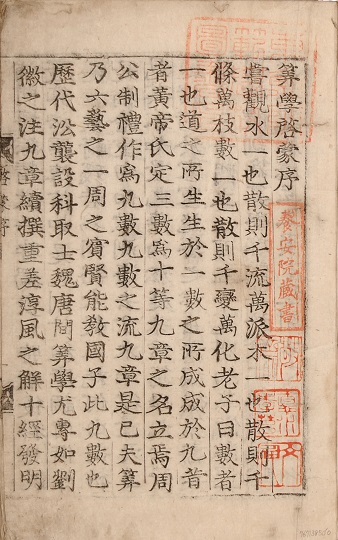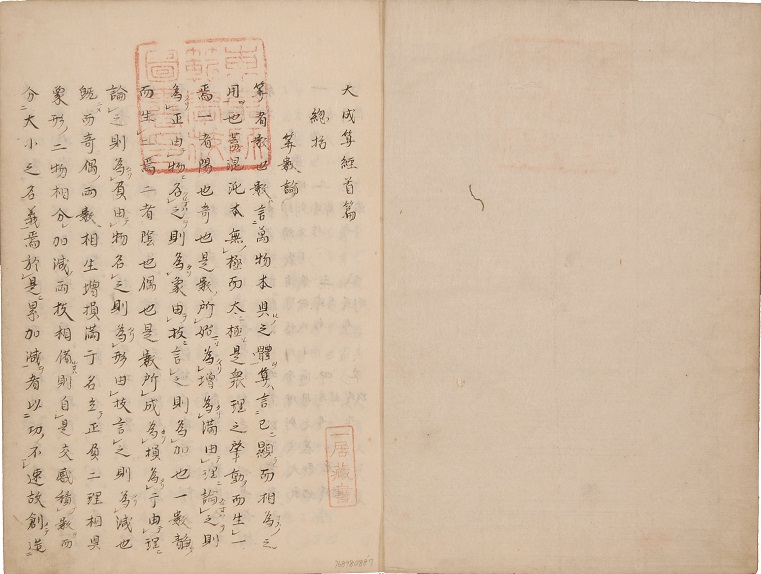|
|
電子展示
|
展示資料をご紹介いたします。一部資料は電子図書館上で全文をご覧いただけます。
|
|
第5部 ◆ 和算とその発展 現代数学への系譜 |
|
23. 新編算學啓蒙(しんぺんさんがくけいもう) 3 巻
(元) 朱世傑 撰
[李朝初期]

元の朱世傑は、本書(初版本は1299年)で算木によって一元方程式理論を展開した。本書は、李氏朝鮮で15世紀に印刷された世界最古の伝書であり、銅版活字本である。17世紀の先端数学の一つである和算の前提とみなされている。本書で記された天元術を、関孝和は、多変数高次連立方程式に拡張し、点竄術へと進化させた。
Zhu Shijie in Yuan dynasty developed the theory of equations with one unknownvariable by the "Sangi" (= sticks used for calculations) in this book. Theoriginal first edition was published in 1299. Currently, it is the oldestdocument and was printed by copperplate in the 15th century in Korea. The booktreated the "Tengenjutsu" (solution of equations with one unknown). Takakazu Sekiextended it to the multi-variable high-order simultaneous equations,"Tenzanjutsu".
|
|
24. 宋揚輝算法(そうようきさんぽう) 7巻
(宋) 揚輝 編
宣徳8(1433)年刊

『揚輝算法』は、13 世紀後半の南宋の時代に活躍した数学者揚輝の著述である。その中の『続古摘奇算法』には様々な方陣が紹介されており、関孝和はこの書によって方陣を研究したと言われている。方陣は古墳時代の出土品にも認めることができる。
This is a book by Yang Hui. Yang Hui is a mathematician who flourished inSouthern Sung in the late 13th century. A variety of magic square is introducedin "Xuguzhaiji Algorism" in this book, and Takakazu Seki is said to have studiedthe square by this book. Square can be seen also in the excavated parts of theKofun period.
|
|
25. 大成算經(たいせいさんけい) 20巻
写本

本書は、17世紀に世界先端の数値計算数学を生み出した関孝和が執筆し、その弟子建部兼弘等が加筆・編纂した書である。方陣や多角形のほか、アルベロスの問題と見紛う様な和算に固有な円理問題なども扱われている。関孝和は、天元術を多変数の点竄術に拡張し、世界ではじめて行列式表現を得たことでも知られている。
This is written by Takakazu Seki who lead a numerical mathematics in the 17thcentury, and retouched and edited by Kanehiro Takebe who is one of the hisfollowers. The problem characterised by Wasan such as circle problem, which canbe seen as the square, polygonal or Arbelos' problem, are treated. Takakazu Sekiextends the Tengenjutu to Tenzanjutu terms of the multi-variable, it is alsoknown that it was the first time to obtain a matrix equation expressed in theworld.
|
|
26. 新篇塵劫記(しんぺんじんこうき) 3巻(存2巻)
吉田光由 著
寛永18(1641)年刊

『塵劫記』(初版1627年)は、江戸時代を通じて改版され続けた。その改版過程で生み出された遺題継承は、問題を出し合い解答しあう、万人が愉しむ数学文化を生み出した。一般庶民が算額を社寺に奉納する文化的営みは、地域でなされた遺題継承である。筑波大学蔵書の内の1点はその最初の遺題本(1641年)である。
This book has continued to be revised through the Edo period. The inheritance of"Idai" ( = challenging problems the mathematicians left) on the revision processproduced mathematical culture that people present, answer, and enjoy mathematicseach other. Cultural life of the general people to dedication "Sangaku" toshrines and temples is one of the regional inheritance of "Idai". Its first"Idaibon (1641)" (= book with collected "Idai"s) is one of the books inUniversity of Tsukuba Library.
|
|
27. 勘者御伽双紙(かんじゃおとぎそうし) 3巻
中根彦循 著
寛保3(1743)年刊

庶民が愉しむ数学書の中で本書は、その挿絵の美しさにより当時の文化における和算の浸透をうかがう書として知られている。最初の遺題本より100年を経た書でもあり、当時の高等和算にまで言及している。漫画付数学通俗書という一面も備えた本書は、和算を愉しむ心が庶民に浸透したことの証でもある。
This book is an enjoyable mathematics document and well known as beautifulinserts which tells the penetration of "Wasan" among the common people at thattime. It has been published over 100 years from the first "Idaibon" and referredup to the high class Wasan. It also includes one side that popular mathematicsdocument with cartoon as evidence of the fact that the heart of the pleasurepenetrated into the common people.
|
|











